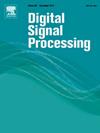近场宽带IIR波束形成器的设计与性能限制
IF 3
3区 工程技术
Q2 ENGINEERING, ELECTRICAL & ELECTRONIC
引用次数: 0
摘要
本文考虑了基于IIR滤波器的近场宽带波束形成器的设计,实现了空间滤波和频率滤波。设计问题被表述为最小化期望响应与实际响应之间的误差的最优极小问题。为了证明所提出的基于FIR的波束形成器相对于传统FIR设计的理论优势,我们引入了一种新的性能极限分析框架,其中滤波器长度被视为任意设计参数。通过求解一系列函数优化子问题,可以有效地计算出该性能极限。这项工作的一个关键理论贡献是证明FIR和IIR波束形成器收敛到相同的性能界。然而,所提出的IIR结构用更少的滤波器系数实现了这一界限。这一发现为在实际应用中选择合适的滤波器长度提供了有价值的指导。此外,我们提出了一种新颖的简化结构,其中所有数组元素共享一个公共反馈部分,在不牺牲性能的情况下提供额外的简化。通过不同混响时间的室内仿真模型对该方法进行了评价。数值实验表明,IIR设计方法比基于FIR的波束成形器更快接近最优值,并且在性能极限上,与FIR波束成形器相比,所有简化的结构在滤波器长度方面都有显著的减少。本文章由计算机程序翻译,如有差异,请以英文原文为准。
Design and performance limit of near-field broadband IIR beamformers
This paper considers the design of near-field broadband beamformer based on IIR filters, performing both spatial and frequency filtering. The design problem is formulated as an optimal minimax problem to minimize the error between the desired response and the actual response. To demonstrate the theoretical advantage of the proposed IIR-based beamformer over conventional FIR designs, we introduce a novel performance limit analysis framework in which the filter length is treated as an arbitrary design parameter. This performance limit can be efficiently computed by solving a sequence of functional optimization subproblems. A key theoretical contribution of this work is the proof that both FIR and IIR beamformers converge to the same performance bound. However, the proposed IIR structure achieves this bound with significantly fewer filter coefficients. This finding provides valuable guidance for selecting appropriate filter lengths in practical applications. Furthermore, we propose a novel reduced structure in which all array elements share a common feedback section, offering additional simplification without sacrificing performance. The proposed method is evaluated by means of a room simulation model for various reverberation times. Numerical experiments have shown that the optimal value of the IIR design method can approach the limit faster than FIR-based beamformers, and all reduced structures achieved significant reduction in terms of filter lengths comparing with FIR beamformers in the performance limit.
求助全文
通过发布文献求助,成功后即可免费获取论文全文。
去求助
来源期刊

Digital Signal Processing
工程技术-工程:电子与电气
CiteScore
5.30
自引率
17.20%
发文量
435
审稿时长
66 days
期刊介绍:
Digital Signal Processing: A Review Journal is one of the oldest and most established journals in the field of signal processing yet it aims to be the most innovative. The Journal invites top quality research articles at the frontiers of research in all aspects of signal processing. Our objective is to provide a platform for the publication of ground-breaking research in signal processing with both academic and industrial appeal.
The journal has a special emphasis on statistical signal processing methodology such as Bayesian signal processing, and encourages articles on emerging applications of signal processing such as:
• big data• machine learning• internet of things• information security• systems biology and computational biology,• financial time series analysis,• autonomous vehicles,• quantum computing,• neuromorphic engineering,• human-computer interaction and intelligent user interfaces,• environmental signal processing,• geophysical signal processing including seismic signal processing,• chemioinformatics and bioinformatics,• audio, visual and performance arts,• disaster management and prevention,• renewable energy,
 求助内容:
求助内容: 应助结果提醒方式:
应助结果提醒方式:


